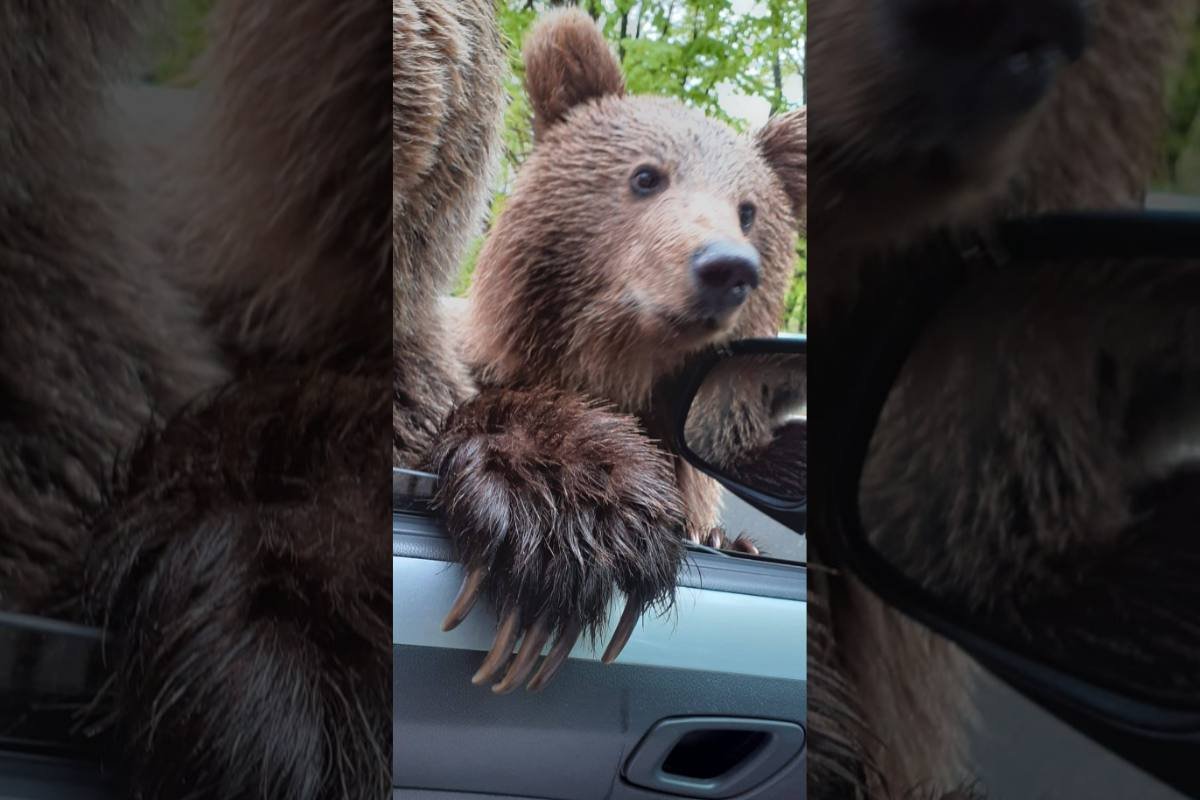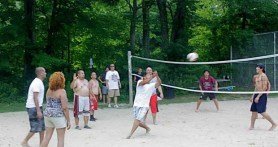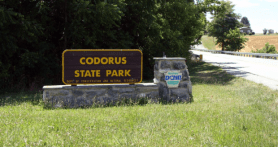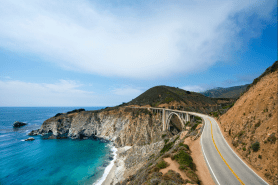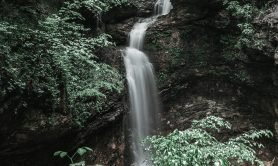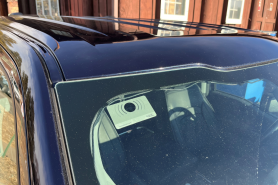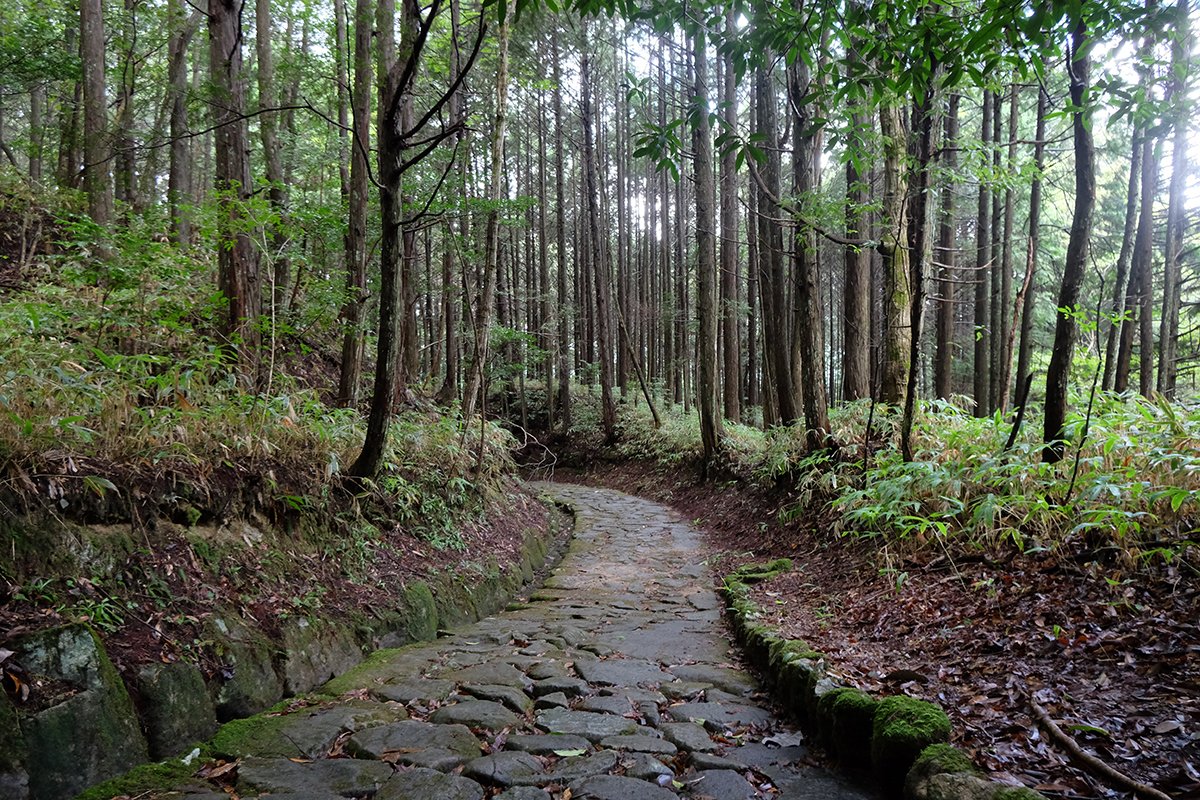

Low wooden buildings strung with lanterns, villages lost in time, and mist clinging to majestic cedars captivated me. After watching a travel show about Japan’s Nakasendo Trail, I moved this long-distance hiking route to the top of my wanderlust list. With my husband’s recent retirement and our youngest off to college, our empty nest status made October the perfect time to go. Hoping for fall colors and an escape from Florida’s enduring heat, we booked the trip.
The Nakasendo Trail connected Japan’s Imperial capital of Kyoto to the political capital of Edo, now modern-day Tokyo. During the Edo period (1603-1868), there were 69 post towns along the 500-kilometer route, some with lavish residences for Imperial travelers. We would be following the footsteps of emperors and princesses who traveled here over 400 years ago.
The lure of history, remote hiking, and exotic culture made this trip an obvious choice. In an age where every travel experience can be viewed and vetted before leaving home, not knowing much about what we would encounter along the way was part of the intrigue. The remote post towns along the way aren’t splashed all over the internet, leaving the thrill of discovery.
We decided to travel light and shipped our suitcases (easy and inexpensive) from Tokyo to our hotel in Kyoto, where we would stay after the hike. Knowing that I would be carrying everything on my back for four days, I scrutinized every item. Could I hike in the same pants every day? Comb my hair with my fingers? I pared down every ounce before we left home, and put all of my hiking gear into a 5-gallon Ziploc bag inside my suitcase. This made it easier to pack my backpack in Tokyo, leaving the sightseeing clothes behind.
Pro Tip: Light hiking shoes or trail running shoes are OK. Trekking poles aren’t essential, but I wish I’d brought mine for some sections that were slippery after it rained. And as always, it’s a good idea to carry a hiking watch.
Day One – Magome to Tsumago
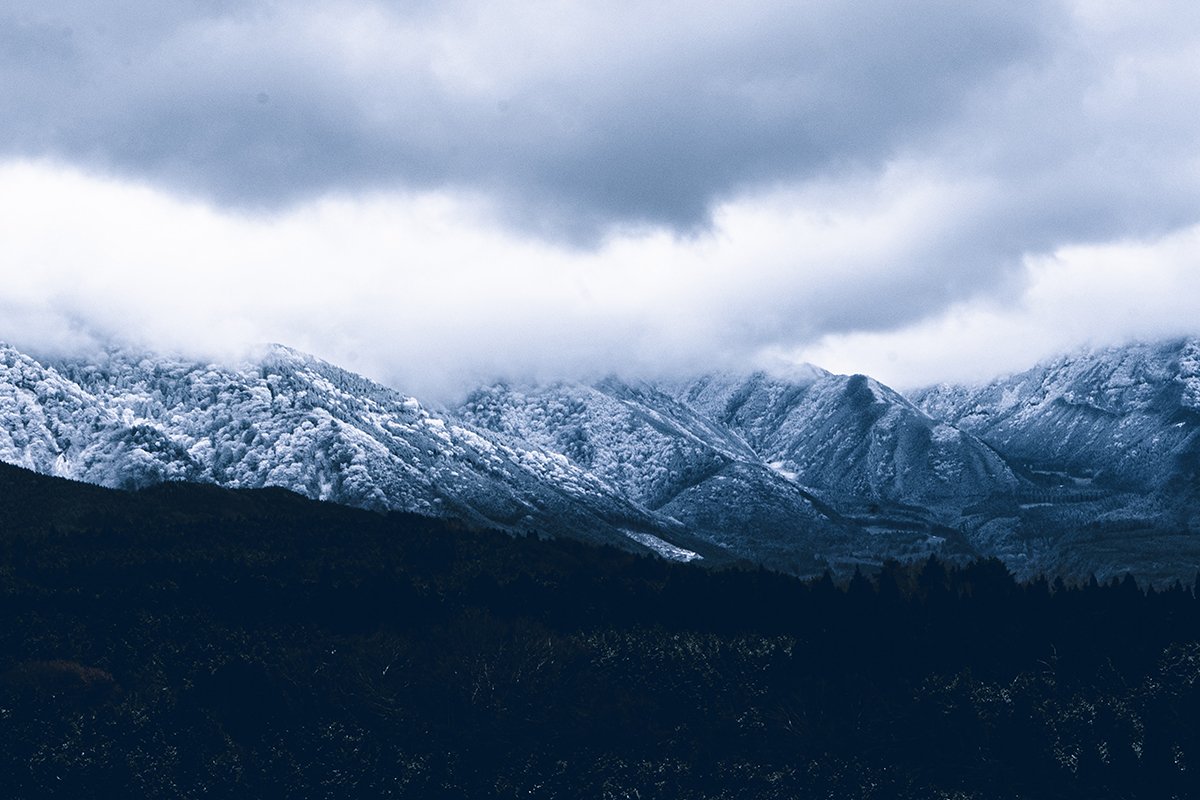
After a dry run the day before to make sure we could find the correct platform in Tokyo’s frenetic Shinjuku Station, we hoisted our backpacks and started off. As my husband read off the directions from our packet of information, I felt like a contestant in The Amazing Race, searching for our next destination. We weren’t racing for a million dollars, but I still felt butterflies in my stomach.
We reached our starting point in Magome after taking two trains and a bus, feeling proud of our route-finding skills on this unique adventure. Our enthusiasm dampened slightly when we saw crowds of tourists milling around the small town. So much for a solo hike through the wilderness, I thought. It turns out, Magome, in the scenic Kiso Valley, is popular for day trippers. Thankfully, the groups of ladies in high-heeled shoes and the busloads of giggly teenagers in school uniforms wouldn’t be joining us on the hike.
Breathtaking Scenery
After snapping a selfie, we started up the steep stone path out of the village. Vendors selling mochi snacks, ice cream, and souvenirs lined the road. Fire destroyed much of Magome’s wooden buildings in 1895, and it was rebuilt in traditional style. We passed the Honjin, which was kind of like a fancy hotel for high-ranking travelers and continued to the top of the hill. Stopping to take in views of Mt. Ena and the surrounding hillside was a good excuse to catch my breath.
With helpful turn-by-turn directions provided by tour operator Oku Japan and well-marked signs along the route, there was no fear of getting lost. Oku Japan specializes in introducing travelers to the “real Japan” away from crowds. We chose the self-guided option, which included our train tickets, hotels along the route (with dinner and breakfast), and hiking instructions.
We had the whole afternoon to cover roughly 5 miles to Tsumago, our first stop. The going was slow—and not because of the occasional steep stairs. It was the scenery that held us back, as we stopped to take photos and marvel at our surroundings. The Nakasendo, which means “middle mountain route,” took us through cedar forests and bamboo groves, past small farms and waterfalls. We rang the bell at the edge of the forest to warn resident bears of our arrival and stopped for tea brewed over a fire. Purple wildflowers, wild strawberries, and numerous shrines decorated the trail.
Arriving in Tsumago
As we neared Tsumago, the trail descended into the village. I bought a small glass paperweight painted with cherry blossoms to commemorate this leg of the trip. At another shop, I chose a mochi-covered dried persimmon. The saleswoman carefully wrapped this sweet snack in elegant paper, a gracious token of welcome to our first stop.
We followed the clues to our lodging, a 200-year-old traditional style inn known as a ryokan. Stepping inside, we took off our shoes and put on slippers provided by our host, who bowed and smiled repeatedly to welcome us. After a quick tour of the dining and bathing areas of the six-room inn, we arrived at our room with tatami-mat floors and sliding paper-paned doors. A kettle of hot water and green tea greeted us, and our host indicated he would make up our futons in the separately partitioned sleeping area during dinner.
Our room came with two sets of blue and white yukatas (Japanese gowns) that we could wear during our stay. I carried mine down the hall and enjoyed the luxury of a hot bath in the communal tub. I had read about proper bathing technique, so I knew to soap and rinse before sliding into the tub for a soak. Slipper etiquette, however, took a little getting used to; wear house slippers around the inn, but not on the tatami mat. Different slippers are provided for the toilet and should only be worn in that area. My husband had to gently remind me when I came back from the facilities and almost stepped into our room with the toilet shoes.
Treated Like Royalty
Dinner was an elaborate multi-course affair. I lost count after a dozen dishes, from black carp sashimi to small, tempting vegetable dishes and soba noodles. Don’t worry if you’re not an intrepid eater, many dishes are just a mouthful, and it’s fair play to trade with your traveling partner if you’re not keen on something. Our host was so gracious, bowing and backing away as he served us. I tried my best to honor his hospitality by cleaning my plate.
After dinner, we strolled the streets of Tsumago dressed in our yukatas and hiking shoes, carrying paper lanterns provided by the inn. Dressed in traditional Japanese clothing and walking through this village of wooden, Edo-period buildings, I felt like I had stepped into a fairy tale. It was surreal and magical. Back in our room, I drifted off to sleep to the sound of the fountain in the koi pond below, thinking I could get used to traveling like an emperor.
Day 2 -Tsumago to Noriji
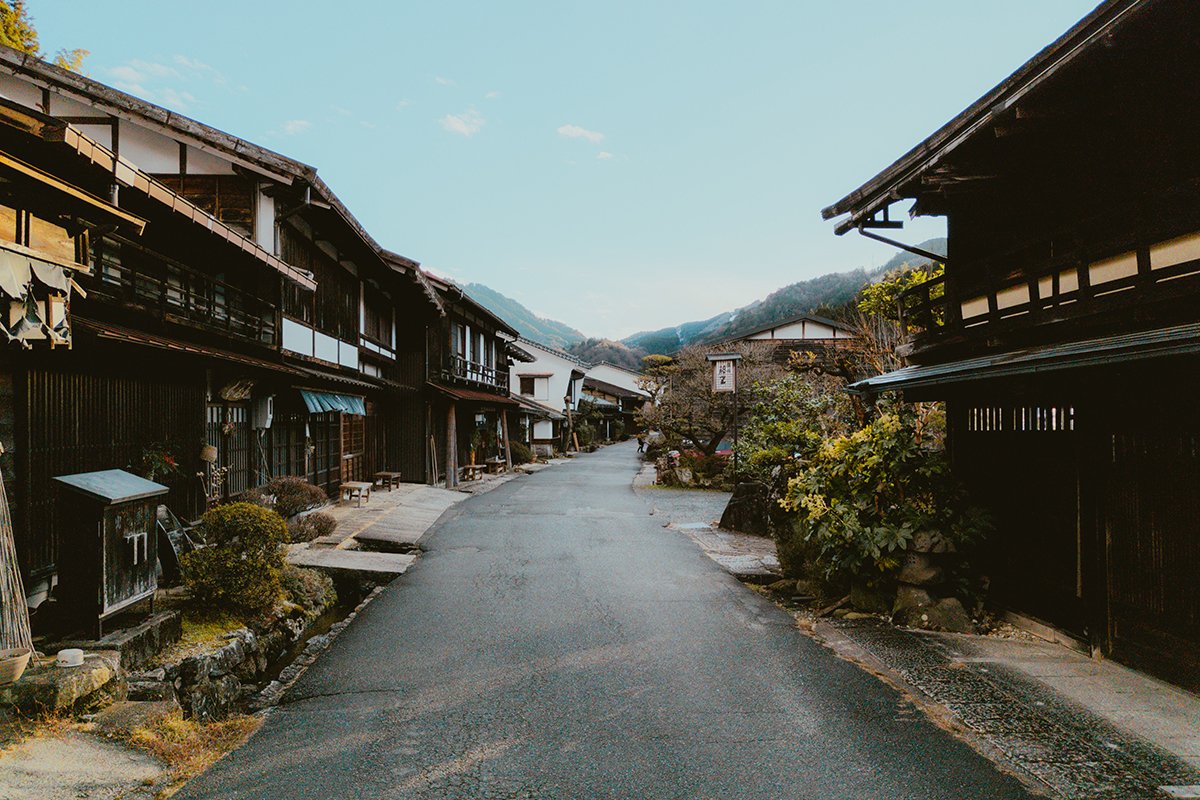
After a quick, early breakfast of salmon, a fried egg, and pickled vegetables, we hit the trail. We vowed to be more disciplined with our pace, since we had to catch a 3 o’clock train for the final leg to our hotel. We had 11 miles to cover, the longest hike of the trip. My resolve weakened early when I stopped to take pictures of a water mill and a self-serve persimmon stand. We picked up the pace through the bamboo forest, slowing long enough to snap a photo and ring the requisite bear bell.
After about an hour, we came to the town of Nagiso, where we stopped at a supermarket to buy some buttery rolls, ham, and Kit-Kats for lunch. We got a little turned around leaving the store, and I was thrilled to put my language studies to practice, asking for help in Japanese. While most of the people we encountered didn’t speak much (if any) English, they were unfailingly helpful and gracious. An elderly lady walked us to the edge of town, pointing the way to the Nakasendo Trail.
As we climbed away from the village, we had sweeping views of the Kiso Valley and the tiny hamlets that lay nestled in golden fields. Verdant mountains rose up in the background. Most of the day we walked in solitude, a gurgling creek and the occasional ohayo or konnichiwa from farmers in the fields breaking the silence. In the quiet, I reflected on nature and my good fortune to be in this place. Our speedy pace meant we arrived at the train station in Noriji with time to spare. I finished a few snacks I had in my backpack and gratefully accepted a walnut cookie from a Japanese hiker who waited with us.
The 40-minute train ride to Kiso-Fukushima was just long enough to admire the fall colors on the hillside and rest up for the final leg of the day: a short 15-minute walk to the hotel. Passing a public foot bath on the way to the hotel, I promised my feet they would soon be soaking in the hotel’s onsen. Our home for the night was The Onyado Tsutaya, a boutique traditional inn with an indoor and outdoor bathing area.
Enjoying the Onsen
We stepped into the lobby and were warmly greeted by a smiling, bowing receptionist who made me feel so humble and welcome. I left my muddy hiking shoes at the door and accepted a yukata and slippers before being shown to our room. Traditional in style, with tatami mat floors and futons, this room had the added luxury of an en suite shower and toilet. The slippers for the lavatory were helpfully embroidered with the word “toilet.” They must have heard I was coming.
We had a few hours before dinner to enjoy the onsen. After 36,000 steps of walking, a hot soak was bliss. I dressed for dinner in my yukata, fumbling with the belt that tied in the back. Our table was set like a royal banquet. Manju leaf wrapped morsels, lotus root, hot egg custard with shrimp, grilled chicken with homemade miso, shabu shabu with Japanese beef and Ponzu sauce were just a few of the highlights. I’m still dreaming about dessert: a tiny square of persimmon cake with a slice of pear and dash of cream cheese. I waddled back to the room in my slippers, and drifted off on my futon like a pampered emperor.
Pro Tip: Some hikers spend a layover day in Kiso-Fukushima, exploring the town’s bakery, artisan coffee house, and small shops. Gongentaki waterfall is an optional day hike from here.
Day 3 – Yabuhara to Narai
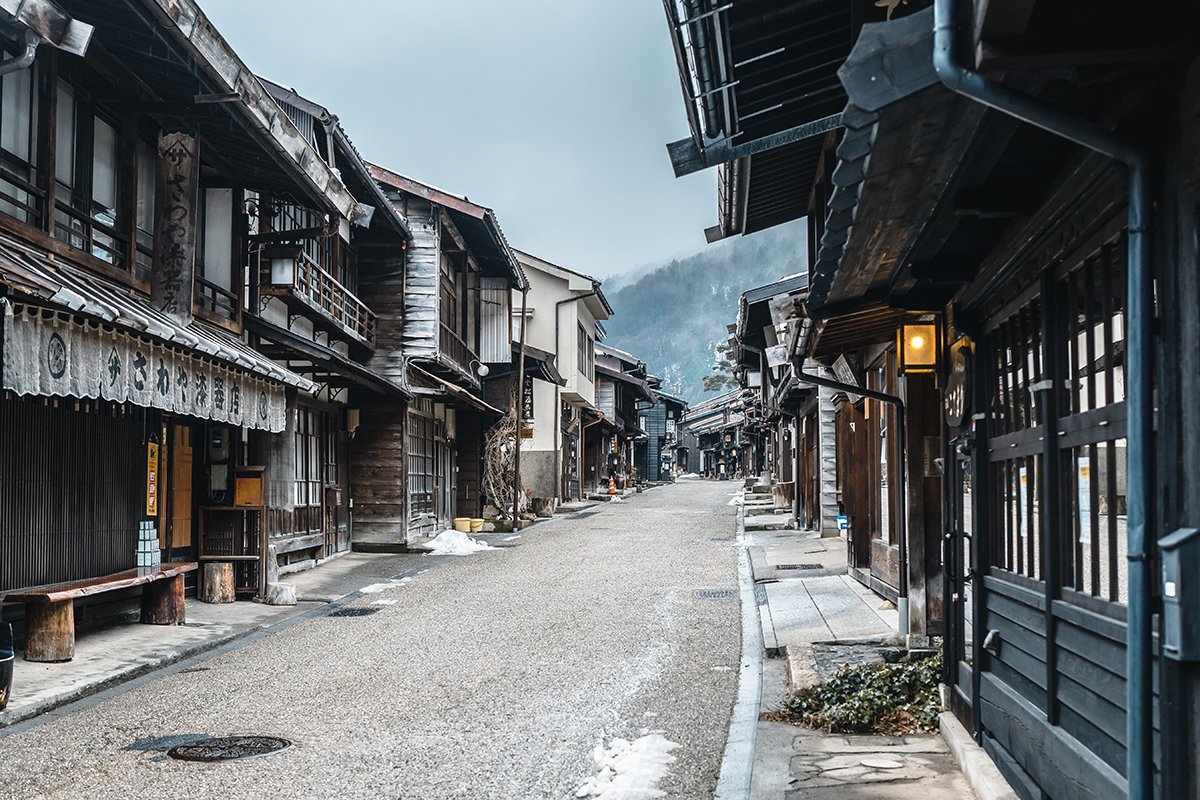
My knees complained as I struggled to get up from the futon. I heard the rain outside and wanted to stay in bed, but I knew there was coffee in the lobby. I took a hot shower, did a few yoga stretches and wrapped myself in a robe before heading downstairs. Coffee in hand, I spent a few minutes checking messages on my phone. Spotty internet connection on this trip was actually a welcome respite from being connected 24/7.
I wasn’t sure I could face another meal after the elaborate dinner, but morsels of shredded burdock, mushrooms, egg omelet, and smoked fish beckoned from dainty red dishes. I’m convinced Japanese eat with their eyes; every dish looked like it stepped out of a painting. Most offerings were just a mouthful or two, making it less intimidating to try new things. What looked like a caterpillar was actually a fried manju leaf stuffed with sweet walnuts. Keep an open mind and don’t judge until you take one “no thank you” bite.
Buying Picnic Supplies
After breakfast, we walked to the grocery store to buy supplies, hoping the rain would stop. Lunch was more rolls and ham, a bag of potato chips, and Scream energy drink, which I hadn’t seen since living in China. We checked out from the hotel, and I donned my pack, which was getting heavier. I was eating my way through the trail mix and Clif bars I had brought from home, but replacing it with souvenirs. I just had to have the jar of Japanese face cream I tried in the onsen; maybe smooth skin will make up for wearing the same clothes for four days on the trail.
The day started with a warm-up uphill walk to the train station and then a quick ride to Yabuhara, where the trail began. The rain stopped, leaving a magical mist on the hillside. Our book of instructions warned that this section would be “one of the hardest parts of the Nakasendo.” The hike was only four miles, but required climbing 1,200 feet of elevation over two miles to reach Torii-touge Pass. The stone path made slippery by the rain meant taking slow, cautious steps, pausing to catch my breath and ring the bear bells. This stretch of the Nakasendo had more bear warning signs than the previous day, leaving me on high alert.
The pass is named “Torii” after a famous local samurai warrior who prayed for victory in battle here during the 15th century. His prayers were answered, and he built a “Torii” gate and a Shinto shrine to commemorate his victory. The views over the Kiso Valley and surrounding mountains were mystical in the morning fog. After a short rest to drink some Scream and grab a handful of trail mix, it was onward to Narai.
A Heart-Pounding Surprise in the Forest
I spotted a brown furry lump sitting on the left side of the trail. Before I could alert my husband, the pile of fluff stood up and turned his pink fleshy face toward me. The creature scampered up a tree, trailed by a little one. We slowed our pace, and suddenly five or six more Japanese macaques came bounding down the hillside, crashing into the bushes in front of us. I went from excited to concerned as more and more monkeys cascaded onto the trail like a waterfall. Reports of monkey maulings flashed through my mind. What do we do? Do they know I still have a ham sandwich in my pack? Who’s more afraid—me or the monkeys? If they were aggressive, we’d lose the fight for sure. Two dozen monkeys blocked our path. I picked up a few rocks, preparing myself for an attack.
The flow of monkeys slowed to a trickle, and we felt safe enough to continue. My heart was racing with adrenaline as we hiked downhill into Narai. Once the most prosperous post town along the Nakasendo, Narai was called “Narai of a Thousand Inns.” It was a resting spot for travelers who descended from the Torii-touge pass. Well-preserved historic buildings line the main street, with numerous shops, cafes, and small inns. Since we were too early to check into our hotel, we browsed for souvenirs. At Atelier Miyuki, I picked up a hand painted Nakasendo T-shirt after chatting with the artist. As the rain began, we ducked into a coffee shop to sip green tea.
Staying in Narai
The innkeepers for the night were a husband and wife who lived on the ground floor of a three-story house. Since there were no other guests, we had the whole place to ourselves. Our host heated water for the bath, which was made from three different kinds of Japanese cypress. It smelled like a forest. I soaked in the steamy tub, inhaling deeply and replaying the day in my mind.
Dinner later followed the pattern of previous nights: sashimi, lots of little plates of vegetables, steamed fish, shabu shabu beef, pickles, and soba noodles. Servings were small, with each bite being of the highest quality. Dessert was three Muscat grapes, and I savored each one.
At the start of the trip, I was nervous about the rustic lodging, not knowing what to expect.
Compared to our cramped Tokyo hotel, the traditional inns along the Nakasendo were spacious and comfortable, with separate sitting and sleeping areas. Tea and cookies were set out, a welcome treat after a day on the trail. The warm welcome we received each night made us feel like honored guests.
Day 4 – Narai to Kiso Hirasawa
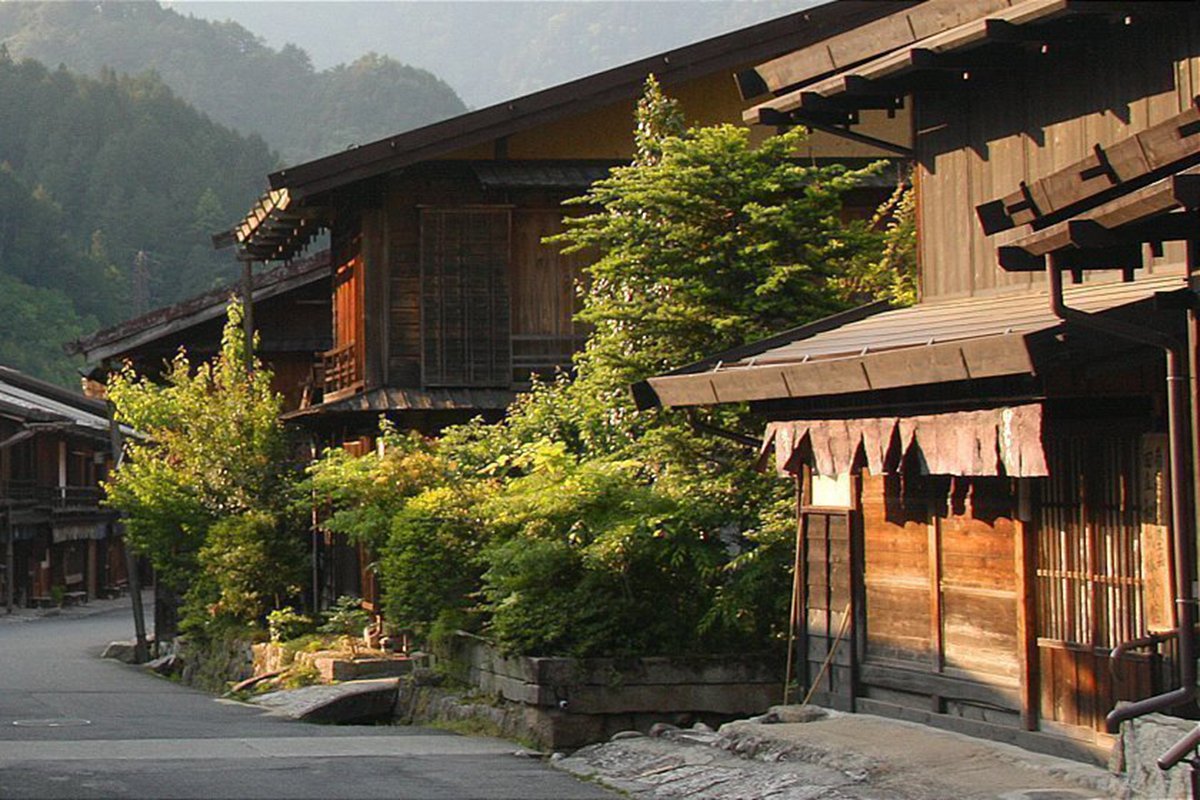
We didn’t have far to go on this final day, so we took a walk around town after breakfast to get a few more steps. My backpack was lighter, since the cool morning air meant I was wearing all of the layers I brought with me. Our first stop in Kyoto was going to have to be a laundromat.
At checkout, our hostess shyly agreed to pose for a photo with me. Even without much English, she exuded hospitality. She handed me some small candies for the journey and waved goodbye.
We followed the river out of Narai and after about an hour, we came to Kiso-Hirasawa. Famous for its lacquerware, the town’s artists produced lustrous bowls, boxes, and vases. We wandered the streets for a bit and then waited for our train in a sunny park. In just a few days, I had gotten used to the peaceful, simple life on the trail. I braced myself mentally for the assault of sights and sounds that Kyoto was sure to bring.
Four days ago, a bullet train from Tokyo launched us back in time. We saw a side of Japan that most travelers don’t see, away from the skyscrapers and crowds. The Nakasendo Trail was paved with surprises. Flush toilets with heated seats waited for us in remote bamboo forests. Elegant, gourmet meals were served in modest inns with no internet and shared toilets.
In this magical kingdom, I learned that hospitality doesn’t stem from fancy accommodations, monkeys aren’t afraid of bear bells, and that I should always leave the toilet slippers where they belong. I can’t wait to go back.

